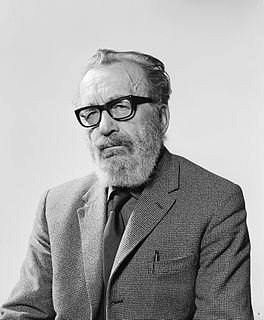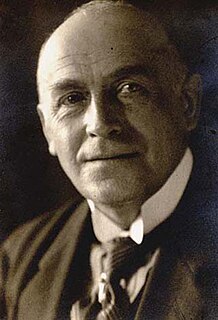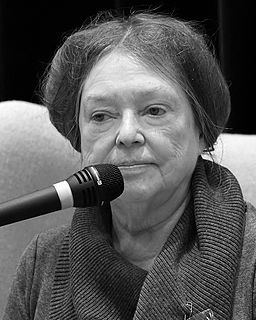Related Research Articles

Tove Irma Margit Ditlevsen was a Danish poet and author. With published works in a variety of genres, she was one of Denmark's best-known authors by the time of her death.

Aksel Sandemose was a Danish-Norwegian writer whose works frequently elucidate the theme that the repressions of society lead to violence.

This is a list of published works by Hans Christian Andersen. The list has been supplemented with a few important posthumous editions of his works; the year given in each entry refers to the first Danish edition. They are all in the public domain because Andersen died over 100 years ago.

August Blom was a Danish film director, producer, and pioneer of silent films during the "golden age" of Danish filmmaking from 1910 to 1914.

Dorrit Willumsen is a Danish writer. She made her literary debut in 1965 with the short story collection Knagen.

Anna Magdalene Thoresen, née Kragh was a Danish-born Norwegian poet, novelist, short story writer and playwright. She is said to have inspired a number of other writers to model characters after her. Her stepdaughter, Suzannah Ibsen, was married to Henrik Ibsen.

Barbra Mathilde Ring was a Norwegian novelist, short story writer, children's writer, biographer, memoirist, literary critic and theatre critic. She made her literary début in 1904 with the girl's novel Babbens Dagbog. Her children's books about "Peik" and other characters achieved great popularity. Her first novel for adults was Jomfruen, published in 1914.
Elise Aubert was a Norwegian novelist, short-story writer, and non-fiction writer.

Marie Bregendahl née Sørensen was one of Denmark's most acclaimed authors of rural literature whose novels and short stories were written in a realistic, almost grotesque style.
Janina Katz was a Polish-Danish writer. A Polish Jew, she emigrated to Denmark in 1969. In 1991, she published her first collection of poems Min mors datter.
Hanne Marie Svendsen is a Danish writer and former broadcasting executive. She has written works on Danish literature, plays and novels, including the award-winning Guldkuglen (1985), published in English as The Gold Ball in 1989.
Bodil Steensen-Leth, née Heide-Jørgensen is a Danish writer.

Bertha Nicoline Tuxen was a Danish painter of still lifes, flowers, and portraits.

Louise Cathrine Elisabeth Bjørnsen, pen name Elisabeth Martens, (1824–1899) was successful as an early Danish female novelist and short story writer. Following in the footsteps of Mathilde Fibiger, she published her first novel Hvad er Livet? in 1855, based on her own experiences as a governess. She went on to write five more novels and four collections of short stories.

Cornelia Frederikke Juliane Victorine von Levetzow (1836–1921) was a popular Danish author of novels and short stories who until 1894 published under the pen name J. Her first work, En ung Piges Historie (1861), a typically Danish governess novel, was a huge success selling some 50,000 copies in several editions and translations. Becoming increasingly religious in her writing, she published many more novels and short stories until 1908, some of them running to several editions.

Alfhilda Theodora Adelheid Mechlenburg née Suenssen (1830–1907), pen name Ivan Ring, was a Danish novelist and short story writer. Brought up by a mother deeply interested in literature, like her younger sisters Fanny Suenssen and Teckla Juel she devoted her life to writing. After first contributing short stories to journals, she published her acclaimed To Fortællinger in 1872. She went on to publish a series of novels and short stories until 1893, gaining wide popularity both in Denmark and Sweden.

Fanny Margrethe Kirstine Suenssen (1832–1918) was a Danish writer. Brought up by a mother interested in literature, like her sisters Alfhilda Mechlenburg and Teckla Juel, she contributed articles to women's magazines and published novels and short stories. Although she suffered from poor health throughout her life and was often bed-ridden, she nevertheless completed her first novel Amalie Vardum in 1862. She published anonymously until the 1890s when she put her name to two collections of short stories.

Christine Dorothea Michelle Elfride Fibiger née Müller (1832–1911) was a Danish writer and philanthropist. She first published a successful cookbook in 1871; then, after her hustand's death in 1873, she supplemented her income by writing a series of novels and short stories, all in support of women's emancipation. These included Askepot (1880) and Præst og Læge (1890). In 1882, she was behind the establishment of a cooking school in Copenhagen, later known as Kjøbenhavns uddannelsesskole for tjenestepiger og vordende husmødre, which she ran until 1889. Her later writings supported vocational opportunities for women, receiving recommendations from government ministries and professional associations. Her memoirs were published posthumously.

Emmy Marie Caroline Thornam (1852–1935) was a self-supporting Danish artist who specialized in flower painting. Initially trained in landscaping, she was later a student of the Danish flower-painter Oluf August Hermansen before completing her studies in Paris under the French flower painter Pierre Bourgogne. In later life, she wrote novels as well as her own memoirs. Her paintings are in the collections of several Danish museums. Her younger sister, Ludovica Thornam, is also remembered as a painter.

Vodroffsvej 10 is one of several surviving 19th-century villas situated on the west side of St. Jørgen's Lake in the Frederiksberg district of central Copenhagen, Denmark. Built in 1865, it was one of three villas constructed in the area by master mason and architect J.W. Frohne (1832-1909) for family members of the owner of nearby Vodroggsgård. An atelier in the garden was constructed in 1882 for the painter Laurits Tuxen, brother-in-law of the next owner and also a resident of the building. Other artists to have used the atelier include Julius Schultz, Hans Gyde Petersen and Daniel Hvidt. The house and atelier were both listed in the Danish registry of protected buildings and places in 1980. The neighboring villa at No. 8 was also constructed by Frohne and is also heritage listed. Bonnie Mürsch — a lawyer whose father purchased the house in 1940 and is herself still living in one of its three apartments — published a book about it in conjunction with its 150th anniversary in 2015.
References
- 1 2 "Fanny Tuxen (1832-1906)" (in Danish). Danske Litteraturpriser. Retrieved 5 September 2022.
- 1 2 3 4 Winge, Mette (2003). "Fanny Tuxen (1832 - 1906)" (in Danish). Kvinfo. Retrieved 5 September 2022.
- 1 2 3 Hesselaa, Peder (20 March 2014). "Fanny Tuxen" (in Danish). lex: Dansk Biografisk Leksikon. Retrieved 5 September 2022.
- ↑ "Corfitz Seeman". Geni. Retrieved 6 September 2022.